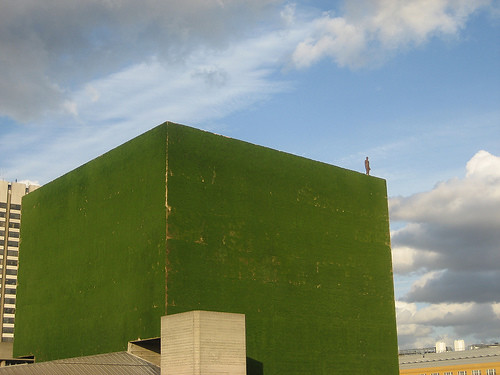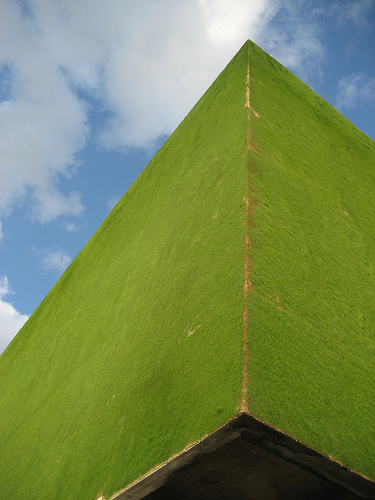
Remember the "Black Square" by Kazimir Malevich?
National Theater's Lyttelton flytower ("flytower" is a part of a theatre above the stage), which is the artists' largest exterior work to date, is the embodiment of Malevich idea in architecture, only it's green and alive (though for a limited time). Sponsored by Bloomberg and produced by Artsadmin, this $100,000 "living' installation has transformed the well-known London landmark into a vertical green marvel, on which only clouds and passing airplanes seem to "graze".



(images credit: Simon, UK)

(image credit: newsfeed.kosmograd.com)

(image credit: nt-online.org)
760 sq.meters covered by grass, 30-meters high. 22 people from Artsadmin seeding grass on 10 levels, using some 2 billion seeds:

(image credit: ashdendirectory.org.uk)
Grassing the FlyTower
by Robert Butler, April 2007
You might expect the first line of a play to have an impact on a theatre audience. You might not expect it to have an impact on the building itself. But anyone who sees the National's Lyttelton fly tower covered in grass this summer (and wonders why) should turn to the work of the Swedish playwright August Strindberg.
Two years ago the National Theatre presented Caryl Churchill's version of Strindberg's A Dream Play. This surrealist drama, written in 1901, opens with the line, “Look how the tower has grown.” Before rehearsals, the director Katie Mitchell rang two artists she knew and left a message. Heather Ackroyd and Dan Harvey are best known for their pioneering use of grass. In 2003 they grew the inside of Dilston Grove, a deconsecrated concrete church in Bermondsey.
The whole interior of the building was carpeted in grass seedling that germinated, flourished and died. Katie Mitchell's message on their answerphone suggested that their next project might be the Lyttelton fly tower.
By chance, this was an idea that had occurred to the artists themselves. When Ackroyd and Harvey started working together in 1990, they used to pass the National Theatre (crossing Waterloo Bridge on the bus home to Brixton) and “wondered idly” about covering the fly tower. They dismissed the idea because they had never worked on that scale. Seventeen years later, this is exactly what they are going to do. It will be their biggest project to date.
Among many projects, in the intervening years, they have grown grass on the facade of the former Swiss Cavalry riding school in Zurich and a mausoleum in Riga. But Dilston Grove had been the most ambitious in size. “The church was such a large scale work,” says Ackroyd, “we had a sense that we could do something of this scale.”
They won't be doing all four sides of the fly tower. It's the right angle facing Waterloo Bridge that appeals to them most. The east side was never an option as it looks straight onto another wall of the theatre. “It's like the back of the fridge,” says Ackroyd. They will be doing the north and west sides (north faces the river; west faces Parliament). In total, the area they will cover is 760 square metres, larger than the 725 square metres inside Dilston Grove.
It's a big task, and one that has to be done quickly, which is why Ackroyd and Harvey have recruited 22 assistants. Two tons of clay will be carefully mixed on site. The clay needs to have a definite consistency. “Like cream cheese,” says Harvey. One team will mix the clay. Another team will deliver the materials to the scaffolding. Eight assistants will be up the scaffolding on the north face and another eight on the west face.
These two teams will apply a thin layer of clay to the concrete surface and then take handfuls of germinated seeds (that have been soaked in sacks) and push them into the clay. Ackroyd and Harvey estimate each assistant can cover 20 square metres a day.
They will be using 25 sacks of seed. Most of that will be standard amenity grass: a mix of fine-leaf perennial rye grass and creeping red fescue that is used in parks and on football pitches. But there will also be some very new seed that is drought resistant (a sign of the increasingly hot summers). Each sack weighs 25 kilos. “We were trying to work out, in a rather anorakish way,” says Ackroyd, “how many seeds would be up there, and the man at British Seed Houses estimated that in a gram of seeds you get 3000 individual seeds.” That's 25 x 25 x 1000 x 3000 = 1,875,000,000 seeds.
Within hours, then, nearly two billion seeds will be getting thirsty. Trying to find the right water source has delayed the project, which was originally scheduled for last September. The 'FlyTower' was never going to be an artwork that could accommodate a hosepipe ban. The way round has been to access the 'ground water' that collects in the National's carpark, and pump it from the basement to the fly tower.
The water had to be sent off to be tested. It's not drinkable, of course – there will be no 'gently carbonated' FlyTower water available in the foyers – but it's not saline either. It's fine for watering the grass and fine, too, for many other uses round the building. Until the tests were done, the National was piping ground water straight to the sewers, now it is using the water in other areas. It is a win-win situation: the theatre has saved on its Thames Water bill and introduced another energy-saving measure.
It will take the seeds two to three days to reorientate themselves on the clay surface, and then delicate green blades will appear. Rye grass takes five to seven days to germinate, fescue eight to ten days. After a week, the scaffolding and protective netting will be taken down and the grass exposed to the elements. Soon after, Ackroyd and Harvey will stop watering the grass and allow the luxuriant pelt to follow its own course. The cycle of growth and decay will make a striking contrast to the immutable concrete strata of Denys Lasdun's design. Five weeks later, a skip will arrive, the senescent grass will be peeled off, and the concrete underneath will look (as last year's trial showed) a little bit sprucer.
It would be wrong to think of Ackroyd and Harvey as guerrilla gardeners. An art catalogue would place 'FlyTower', very properly, within a framework of pieces that present natural processes in places of architectural interest. 'FlyTower' would be seen as a time-based exhibit that combines Ackroyd and Harvey's interest in sculpture, botany and ecology. It would be related to the bio-chemical researches that Ackroyd and Harvey have done on chlorophyll that underpins (in other work) their use of photosynthesis, and to the recent crystallised whale skeleton, that demonstrates their preoccupation with transformation. The art critic, no doubt, would touch on themes of erosion, transience and evanescence.
Later in May, the South Bank will become the site for another new work of art. The sculptor Antony Gormley is placing sculptural casts of his body on rooftops and public walkways across London. 'Event Horizon' has been commissioned by the South Bank Centre to celebrate the re-opening of the Festival Hall. The arrival of human figures across the city skyline will probably coincide with the fading of the 'FlyTower' grass. Some may find an ecological message in this.
In 1893, Strindberg was in London during an abnormally hot summer. When he crossed Waterloo Bridge, he suffered a hallucinatory attack. It's unlikely, now, that he will be the only person to cross Waterloo Bridge and imagine that he or she is seeing things. As the first line in A Dream Play says, “the tower has grown”.
© Robert Butler, April 2007

No comments:
Post a Comment